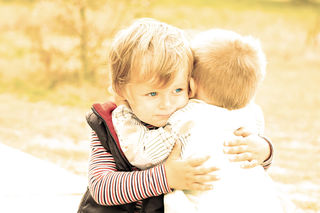Empathy
Prepared to Care: The Case for Kindness and Self-Kindness
Why kindness and self-kindness go hand-in-hand.
Posted December 7, 2018
Dr. Carolyn Zahn-Waxler is a pioneer in the study of children’s prosocial development. Over her career, she has transformed what we understand about the origins of children’s ability to be empathic, kind, and caring. I had the pleasure of speaking with Dr. Zahn-Waxler last year and asked her about how her experiences with parents and children inspired her to learn more about the development of compassion, empathy, and kindness. She recounted a story told to her by the mother of an 18-month-year-old girl:

“A neighbor asked me to watch her child. After she left the baby began to shriek. He was very upset by my efforts to comfort him, so I put him in a high chair and gave him a cookie. As soon as he began to cry, Julie looked very startled and worried. Her body stiffened. She bent toward him and cocked her head, reaching toward him. He began to throw the cookies. She tried to return them, which surprised me because usually, she tries to eat everyone’s cookies. She put the pieces on the tray and looked very worried. Her eyebrows were up and her lips were pursed. Then I put him back on the floor. She hovered over him whimpering herself and looking at me questioningly. I put him in the playpen and he continued to cry once in a while. She began to stroke his hair, and she reached into the playpen and patted his shoulder. I could hear her cooing and making concerned sounds. Then she came into the kitchen, took my hand and led me to the living room. She kept looking at me with a very concerned, worried look. Then she took my hand and tried to put it on top of Brian’s head.” (Zahn-Waxler, Schoen, & Decety, 2017)
Dr. Zahn-Waxler spoke about this story as a prime example of how we might underestimate the degree of concern even very young children have for others. Spontaneous helping behaviors and tender reactions to the suffering of others emerge very early, and if we look for and notice them, we can encourage them. This is a fundamental building block of kindness and caring.
When I asked Dr. Zahn-Waxler about the most important take-home messages of her 30-year and counting career, she answered, “We come into the world with the potential for caring and connection – some more than others – and for me [the goal is to] understand how these potentials are more fully present in some versus others, what undermines the expression of these potentials, and why they are so fundamental. Evolutionary arguments are convincing. We come into this world prepared to care.”
Dr. Zahn-Waxler has also written about how self-kindness promotes our ability to be kind to others. This makes me think about what happens when we don’t practice self-kindness. For me, a great cautionary tale about kindness without self-kindness is a book by the beloved children’s author Shel Silverstein.
When my daughter was five years old, she found a copy of Shel Silverstein’s The Giving Tree on her bookshelf and wanted it for her bedtime story. I almost refused her because this was the book I hated most as a child. I remember it making me inestimably sad. Why we had a copy of it on our shelf remains a mystery to me. Yet, I couldn’t quite remember all the details of why I hated it, so I went ahead and read the book to my daughter. Oh, right, I thought afterwards, now I remember.
The Giving Tree is about a boy and a tree who are companions. The tree loves the boy, and the boy loves the tree. Then, as the boy grows up, he becomes more interested in the human world and has little need for the tree. Little need, that is, until he wants something from her. As a boy, he needed only her companionship, but as a young man, he needed a laundry list of items from her: apples to sell for money (the tree gives him her apples), branches to build a home (the tree gives him her branches), a trunk to build a boat (the tree gives him her trunk). By the end, she is only a stump. When the tree keeps giving and the boy keeps taking, the tree is happy we are told. Yet towards the end of the book we learn, “but not really.” Tellingly, the boy isn’t happy either. Making money didn’t make him happy, and building a house and starting a family didn’t make him happy. So, he built a boat to sail away and leave it all behind.
In the end, the boy, now an old man, comes back to the tree. The tree is still a stump, and she tells him she has nothing left to give. The old man says he only needs a place to quietly rest, and a stump is perfect for that. The tree is happy to give it.
Leaving aside interpretations around gender relations (the boy and the female tree), I believe that this story is fundamentally about how kindness— if there is no self-kindness in it — disrupts connection and fulfillment and leads to loneliness and unhappiness on the part of the giver and receiver. Taking kindness without reciprocating poisons the well for everyone. Perhaps my childhood distress at reading this book shows that I got what Shel Silverstein was telling us.
The psychologist Erich Fromm wrote much the same when he argued that all love and regard for others must begin with self-love:
“If I can say, “I love you,” I say, “I love in you all of humanity, all that is alive; I love in you also myself.” Self-love, in this sense, is the opposite of selfishness. The latter is actually a greedy concern with oneself which springs from and compensates for the lack of genuine love for oneself. Love, paradoxically, makes me more independent because it makes me stronger and happier — yet it makes me one with the loved person to the extent that individuality seems to be extinguished for the moment. In loving I experience “I am you,” you — the loved person, you — the stranger, you — everything alive. In the experience of love lies the only answer to being human, lies sanity."
Erich Fromm, The Sane Society




